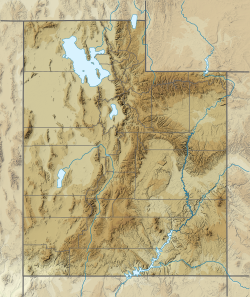| Nugget Sandstone | |
|---|---|
| Stratigraphic range: Norian-Toarcian ~ | |
 Salmon-pink and white sandstones of the upper part of the Nugget Formation, Wind River Mountains, Wyoming | |
| Type | Geological formation |
| Unit of | Glen Canyon Group |
| Underlies | Carmel Formation |
| Overlies | Chinle Formation |
| Thickness | 200 m (660 ft) |
| Lithology | |
| Primary | Sandstone |
| Other | Mudstone, siltstone |
| Location | |
| Coordinates | 40°24′N109°18′W / 40.4°N 109.3°W |
| Approximate paleocoordinates | 27°24′N46°36′W / 27.4°N 46.6°W |
| Region | Colorado, Idaho, Utah |
| Country | United States |
| Extent | Colorado Plateau |



The Nugget Sandstone is a Late Triassic to Early Jurassic geologic formation that outcrops in Colorado, Idaho, Wyoming, and Utah, western United States.
Contents
In Wyoming, it is composed of a lower hematite-stained siltstone and thin-bedded sandstone. The upper part is a salmon-pink and light-gray, fine- to medium-grained cliff-forming sandstone that exhibits massive bedding to large scale cross-beds of dunes. Thickness ranges up to 86.9 m (285 feet). [1]
Fossil theropod tracks have been reported from the formation. [2]

